rear view mirror Alfa Romeo 156 2004 Owner handbook (in English)
[x] Cancel search | Manufacturer: ALFA ROMEO, Model Year: 2004, Model line: 156, Model: Alfa Romeo 156 2004Pages: 357, PDF Size: 5.04 MB
Page 27 of 357
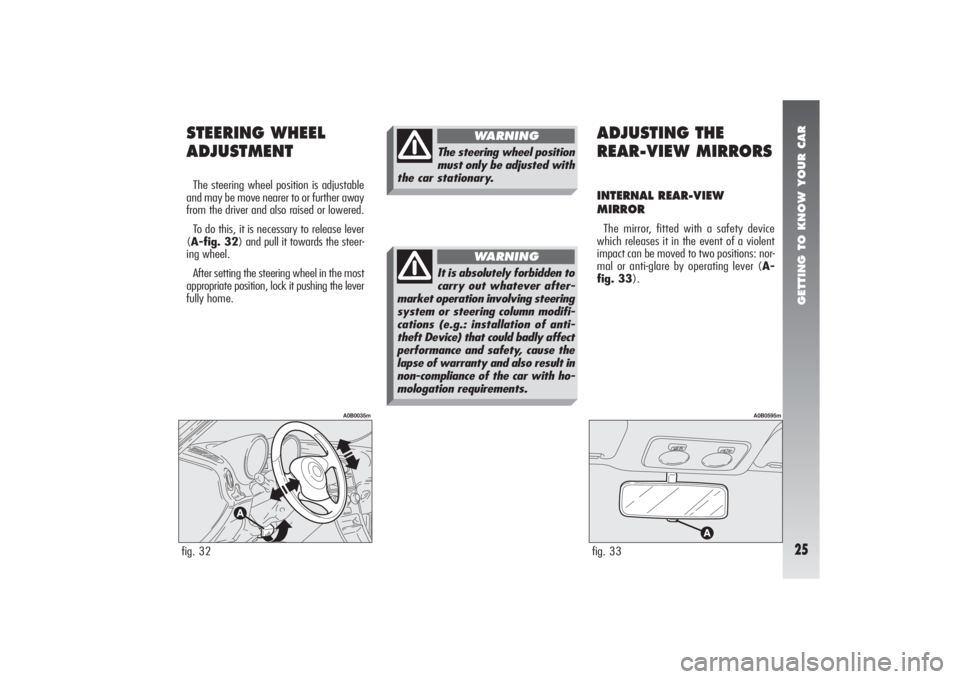
GETTING TO KNOW YOUR CAR25
STEERING WHEEL
ADJUSTMENTThe steering wheel position is adjustable
and may be move nearer to or further away
from the driver and also raised or lowered.
To do this, it is necessary to release lever
(A-fig. 32) and pull it towards the steer-
ing wheel.
After setting the steering wheel in the most
appropriate position, lock it pushing the lever
fully home.
ADJUSTING THE
REAR-VIEW MIRRORSINTERNAL REAR-VIEW
MIRRORThe mirror, fitted with a safety device
which releases it in the event of a violent
impact can be moved to two positions: nor-
mal or anti-glare by operating lever (A-
fig. 33).
fig. 32
A0B0035m
fig. 33
A0B0595m
The steering wheel position
must only be adjusted with
the car stationary.
WARNING
It is absolutely forbidden to
carry out whatever after-
market operation involving steering
system or steering column modifi-
cations (e.g.: installation of anti-
theft Device) that could badly affect
performance and safety, cause the
lapse of warranty and also result in
non-compliance of the car with ho-
mologation requirements.
WARNING
Page 54 of 357
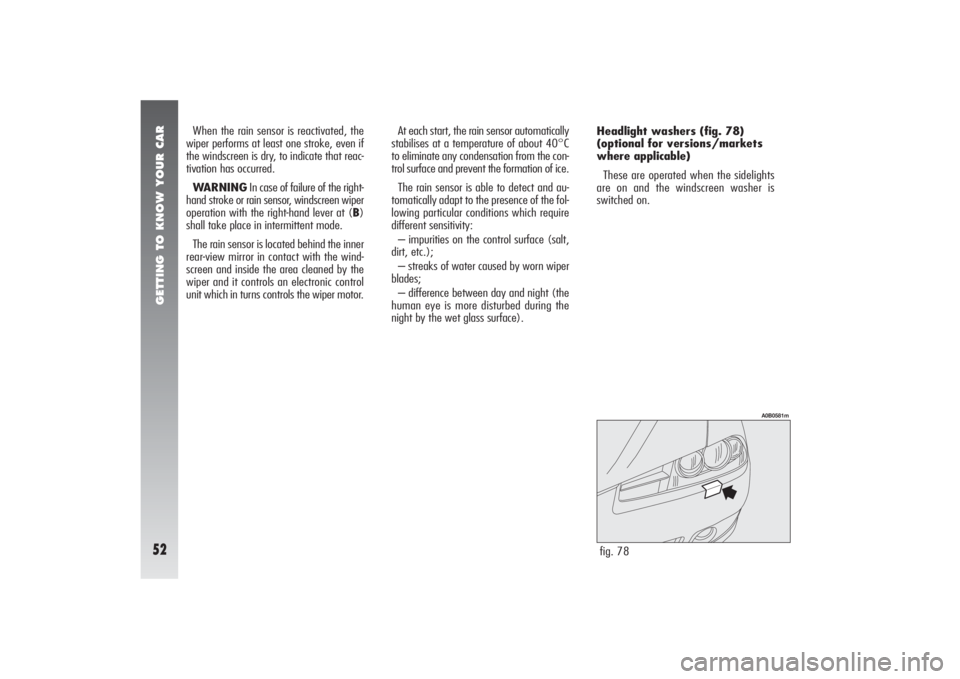
GETTING TO KNOW YOUR CAR52
When the rain sensor is reactivated, the
wiper performs at least one stroke, even if
the windscreen is dry, to indicate that reac-
tivation has occurred.
WARNINGIn case of failure of the right-
hand stroke or rain sensor, windscreen wiper
operation with the right-hand lever at (B)
shall take place in intermittent mode.
The rain sensor is located behind the inner
rear-view mirror in contact with the wind-
screen and inside the area cleaned by the
wiper and it controls an electronic control
unit which in turns controls the wiper motor.At each start, the rain sensor automatically
stabilises at a temperature of about 40°C
to eliminate any condensation from the con-
trol surface and prevent the formation of ice.
The rain sensor is able to detect and au-
tomatically adapt to the presence of the fol-
lowing particular conditions which require
different sensitivity:
– impurities on the control surface (salt,
dirt, etc.);
– streaks of water caused by worn wiper
blades;
– difference between day and night (the
human eye is more disturbed during the
night by the wet glass surface).Headlight washers (fig. 78)
(optional for versions/markets
where applicable)
These are operated when the sidelights
are on and the windscreen washer is
switched on.
fig. 78
A0B0581m
Page 117 of 357
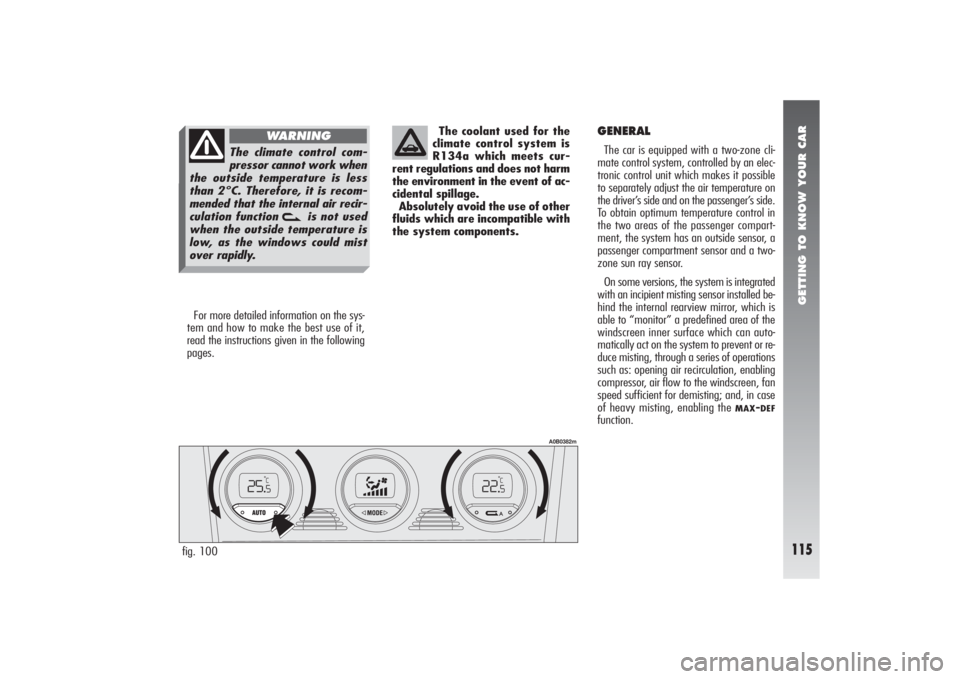
GETTING TO KNOW YOUR CAR
115
For more detailed information on the sys-
tem and how to make the best use of it,
read the instructions given in the following
pages.The coolant used for the
climate control system is
R134a which meets cur-
rent regulations and does not harm
the environment in the event of ac-
cidental spillage.
Absolutely avoid the use of other
fluids which are incompatible with
the system components.fig. 100
A0B0382m
GENERALThe car is equipped with a two-zone cli-
mate control system, controlled by an elec-
tronic control unit which makes it possible
to separately adjust the air temperature on
the driver’s side and on the passenger’s side.
To obtain optimum temperature control in
the two areas of the passenger compart-
ment, the system has an outside sensor, a
passenger compartment sensor and a two-
zone sun ray sensor.
On some versions, the system is integrated
with an incipient misting sensor installed be-
hind the internal rearview mirror, which is
able to “monitor” a predefined area of the
windscreen inner surface which can auto-
matically act on the system to prevent or re-
duce misting, through a series of operations
such as: opening air recirculation, enabling
compressor, air flow to the windscreen, fan
speed sufficient for demisting; and, in case
of heavy misting, enabling the
MAX
-DEF
function.
The climate control com-
pressor cannot work when
the outside temperature is less
than 2°C. Therefore, it is recom-
mended that the internal air recir-
culation function
v
is not used
when the outside temperature is
low, as the windows could mist
over rapidly.
WARNING
Page 194 of 357
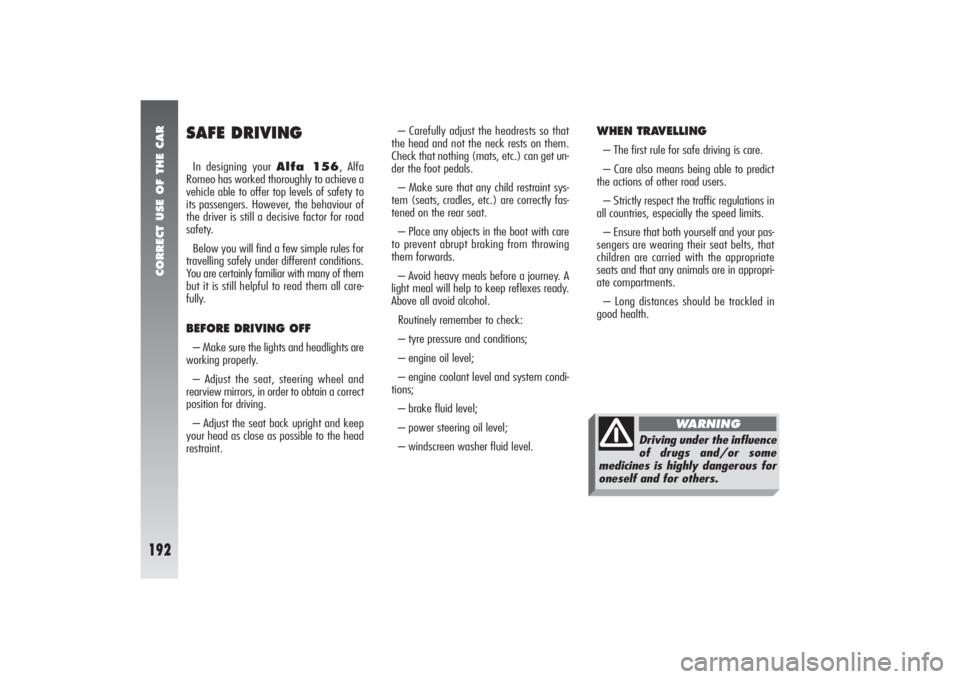
CORRECT USE OF THE CAR
192
SAFE DRIVINGIn designing your Alfa 156, Alfa
Romeo has worked thoroughly to achieve a
vehicle able to offer top levels of safety to
its passengers. However, the behaviour of
the driver is still a decisive factor for road
safety.
Below you will find a few simple rules for
travelling safely under different conditions.
You are certainly familiar with many of them
but it is still helpful to read them all care-
fully.BEFORE DRIVING OFF– Make sure the lights and headlights are
working properly.
– Adjust the seat, steering wheel and
rearview mirrors, in order to obtain a correct
position for driving.
– Adjust the seat back upright and keep
your head as close as possible to the head
restraint.– Carefully adjust the headrests so that
the head and not the neck rests on them.
Check that nothing (mats, etc.) can get un-
der the foot pedals.
– Make sure that any child restraint sys-
tem (seats, cradles, etc.) are correctly fas-
tened on the rear seat.
– Place any objects in the boot with care
to prevent abrupt braking from throwing
them forwards.
– Avoid heavy meals before a journey. A
light meal will help to keep reflexes ready.
Above all avoid alcohol.
Routinely remember to check:
– tyre pressure and conditions;
– engine oil level;
– engine coolant level and system condi-
tions;
– brake fluid level;
– power steering oil level;
– windscreen washer fluid level.
WHEN TRAVELLING– The first rule for safe driving is care.
– Care also means being able to predict
the actions of other road users.
– Strictly respect the traffic regulations in
all countries, especially the speed limits.
– Ensure that both yourself and your pas-
sengers are wearing their seat belts, that
children are carried with the appropriate
seats and that any animals are in appropri-
ate compartments.
– Long distances should be trackled in
good health.
Driving under the influence
of drugs and/or some
medicines is highly dangerous for
oneself and for others.
WARNING
Page 201 of 357

CORRECT USE OF THE CAR
199
TOWING TRAILERSWARNINGS AND
SUGGESTIONS For towing caravans or trailers the vehi-
cle must be fitted with a certified tow hook
and an adequate electric system. Installa-
tion should be carried out by specialised per-
sonnel who release a special document for
circulation on the road.
Install any specific and/or additional rear-
view mirrors as specified by law. Remember
that when towing a trailer, steep hills are
harder to climb, the braking spaces increase
and overtaking takes longer depending on
the overall weight.
Engage a low gear when driving downhill,
rather than constantly using the brake.
The weight the trailer exerts on the vehi-
cle tow hook reduces by the same amount
the actual vehicle loading capacity. To make sure the maximum towable
weight is not exceeded (given in the log
book) account should be taken of the fully
laden trailer, including accessories and per-
sonal belongings.
Drive within the permitted speed limits for
vehicles with trailers. In any case the maxi-
mum speed should never exceed 100 km/h.
INSTALLING THE TOW HOOKThe towing device should be fastened to
the body by specialised personnel according
to the following instructions and any addi-
tional and/or integrative information sup-
plied by the Manufacturer of the device.
The towing device must meet current reg-
ulations with reference to 94/20/EC Di-
rective and subsequent amendments.
For any version the towing device used
must match the towable weight of the ve-
hicle on which it is to be installed.
For the electric connection a unified con-
nector should be used which is generally
placed on a special bracket normally fas-
tened to the towing device.
The ABS system with
which the car may be fitted
does not control the trailer braking
system. Particular care is therefore
necessary on slippery surfaces.
WARNING
Under no circumstances
should the vehicle brake
system be altered to control the
trailer brake. The trailer braking
system must be fully independent
of the vehicle’s hydraulic system.
WARNING
Page 332 of 357
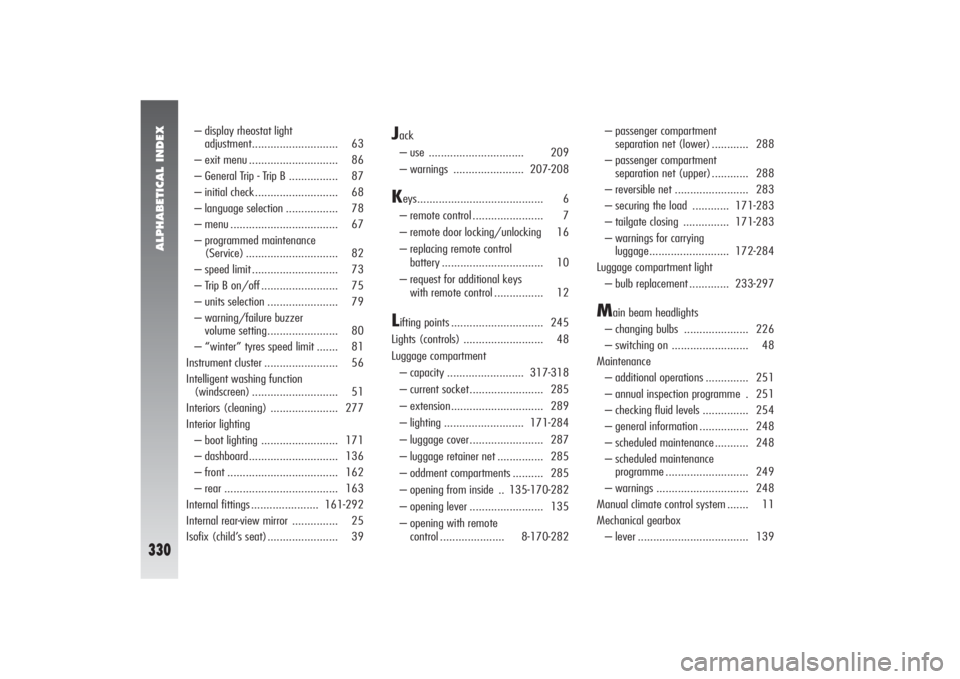
ALPHABETICAL INDEX
330
– display rheostat light
adjustment............................ 63
– exit menu ............................. 86
– General Trip - Trip B ................ 87
– initial check........................... 68
– language selection ................. 78
– menu ................................... 67
– programmed maintenance
(Service) .............................. 82
– speed limit ............................ 73
– Trip B on/off ......................... 75
– units selection ....................... 79
– warning/failure buzzer
volume setting....................... 80
– “winter” tyres speed limit ....... 81
Instrument cluster ........................ 56
Intelligent washing function
(windscreen) ............................ 51
Interiors (cleaning) ...................... 277
Interior lighting
– boot lighting ......................... 171
– dashboard............................. 136
– front .................................... 162
– rear ..................................... 163
Internal fittings ...................... 161-292
Internal rear-view mirror ............... 25
Isofix (child’s seat)....................... 39
Jack
– use ............................... 209
– warnings ....................... 207-208K
eys......................................... 6
– remote control ....................... 7
– remote door locking/unlocking 16
– replacing remote control
battery ................................. 10
– request for additional keys
with remote control ................ 12
Lifting points .............................. 245
Lights (controls) .......................... 48
Luggage compartment
– capacity ......................... 317-318
– current socket........................ 285
– extension.............................. 289
– lighting .......................... 171-284
– luggage cover........................ 287
– luggage retainer net ............... 285
– oddment compartments .......... 285
– opening from inside .. 135-170-282
– opening lever ........................ 135
– opening with remote
control ..................... 8-170-282– passenger compartment
separation net (lower) ............ 288
– passenger compartment
separation net (upper)............ 288
– reversible net ........................ 283
– securing the load ............ 171-283
– tailgate closing ............... 171-283
– warnings for carrying
luggage.......................... 172-284
Luggage compartment light
– bulb replacement ............. 233-297
M
ain beam headlights
– changing bulbs ..................... 226
– switching on ......................... 48
Maintenance
– additional operations .............. 251
– annual inspection programme . 251
– checking fluid levels ............... 254
– general information ................ 248
– scheduled maintenance ........... 248
– scheduled maintenance
programme ........................... 249
– warnings .............................. 248
Manual climate control system ....... 11
Mechanical gearbox
– lever .................................... 139